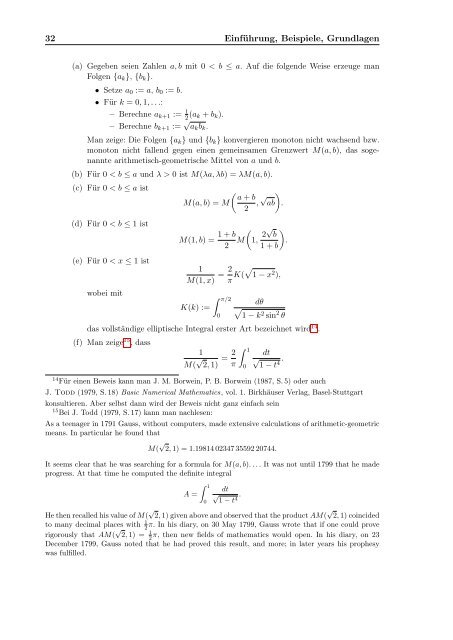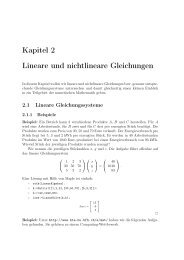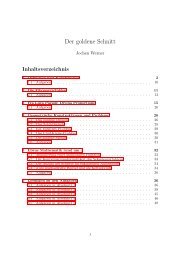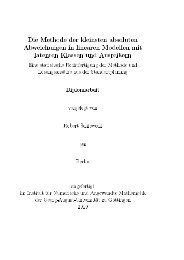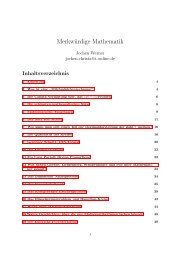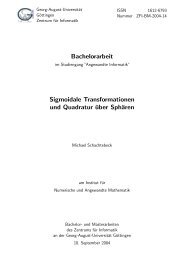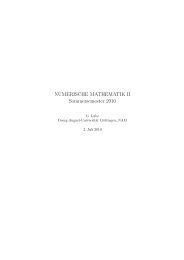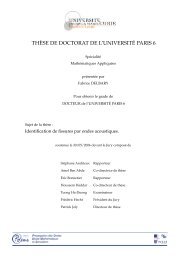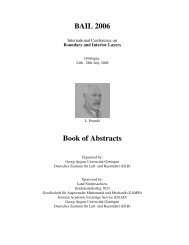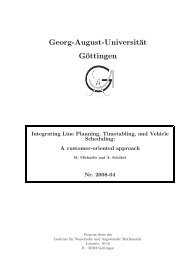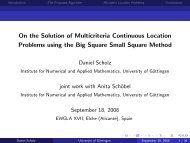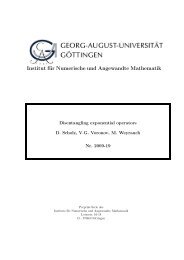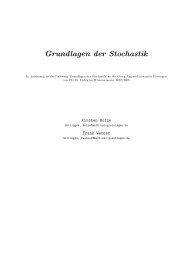- Seite 1: Gewöhnliche Differentialgleichunge
- Seite 4 und 5: ii INHALTSVERZEICHNIS 2.3.2 Stabili
- Seite 6 und 7: Kapitel 1 Einführung, Beispiele, G
- Seite 8 und 9: 1.1 Wachstumsmodelle 3 1.1 Wachstum
- Seite 10 und 11: 1.1 Wachstumsmodelle 5 Wegen F (p(t
- Seite 12 und 13: 1.1 Wachstumsmodelle 7 ausgegangen
- Seite 14 und 15: 1.1 Wachstumsmodelle 9 Dann ist d 4
- Seite 16 und 17: 1.1 Wachstumsmodelle 11 mit λ ∈
- Seite 18 und 19: 1.1 Wachstumsmodelle 13 eqn:={a*x-b
- Seite 20 und 21: 1.1 Wachstumsmodelle 15 (c) Aus k t
- Seite 22 und 23: 1.2 Beispiele aus der Physik 17 R A
- Seite 24 und 25: 1.2 Beispiele aus der Physik 19 1.5
- Seite 26 und 27: 1.2 Beispiele aus der Physik 21 2 1
- Seite 28 und 29: 1.2 Beispiele aus der Physik 23 1.2
- Seite 30 und 31: 1.2 Beispiele aus der Physik 25 die
- Seite 32 und 33: 1.2 Beispiele aus der Physik 27 bzw
- Seite 34 und 35: 1.2 Beispiele aus der Physik 29 2 1
- Seite 38 und 39: 1.2 Beispiele aus der Physik 33 2.
- Seite 40 und 41: 1.3 Elementar lösbare Differential
- Seite 42 und 43: 1.3 Elementar lösbare Differential
- Seite 44 und 45: 1.3 Elementar lösbare Differential
- Seite 46 und 47: 1.3 Elementar lösbare Differential
- Seite 48 und 49: 1.3 Elementar lösbare Differential
- Seite 50 und 51: 1.3 Elementar lösbare Differential
- Seite 52 und 53: 1.4 Funktionalanalytische Grundlage
- Seite 54 und 55: 1.4 Funktionalanalytische Grundlage
- Seite 56 und 57: 1.4 Funktionalanalytische Grundlage
- Seite 58 und 59: 1.4 Funktionalanalytische Grundlage
- Seite 60 und 61: 1.4 Funktionalanalytische Grundlage
- Seite 62 und 63: Kapitel 2 Die Theorie gewöhnlicher
- Seite 64 und 65: 2.1 Existenz- und Eindeutigkeitsaus
- Seite 66 und 67: 2.1 Existenz- und Eindeutigkeitsaus
- Seite 68 und 69: 2.1 Existenz- und Eindeutigkeitsaus
- Seite 70 und 71: 2.1 Existenz- und Eindeutigkeitsaus
- Seite 72 und 73: 2.1 Existenz- und Eindeutigkeitsaus
- Seite 74 und 75: 2.1 Existenz- und Eindeutigkeitsaus
- Seite 76 und 77: 2.1 Existenz- und Eindeutigkeitsaus
- Seite 78 und 79: 2.2 Lineare Differentialgleichungss
- Seite 80 und 81: 2.2 Lineare Differentialgleichungss
- Seite 82 und 83: 2.2 Lineare Differentialgleichungss
- Seite 84 und 85: 2.2 Lineare Differentialgleichungss
- Seite 86 und 87:
2.2 Lineare Differentialgleichungss
- Seite 88 und 89:
2.2 Lineare Differentialgleichungss
- Seite 90 und 91:
2.2 Lineare Differentialgleichungss
- Seite 92 und 93:
2.2 Lineare Differentialgleichungss
- Seite 94 und 95:
2.2 Lineare Differentialgleichungss
- Seite 96 und 97:
2.2 Lineare Differentialgleichungss
- Seite 98 und 99:
2.2 Lineare Differentialgleichungss
- Seite 100 und 101:
2.2 Lineare Differentialgleichungss
- Seite 102 und 103:
2.2 Lineare Differentialgleichungss
- Seite 104 und 105:
2.2 Lineare Differentialgleichungss
- Seite 106 und 107:
2.3 Stabilität 101 Sieht man sich
- Seite 108 und 109:
2.3 Stabilität 103 Ist z. B. n = 2
- Seite 110 und 111:
2.3 Stabilität 105 2.3.4 Periodisc
- Seite 112 und 113:
2.3 Stabilität 107 bzw. x(t) ≤ c
- Seite 114 und 115:
2.3 Stabilität 109 • Ist ɛ ∈
- Seite 116 und 117:
2.3 Stabilität 111 haben wir die L
- Seite 118 und 119:
2.3 Stabilität 113 (a) Es ist x1(
- Seite 120 und 121:
Kapitel 3 Die numerische Behandlung
- Seite 122 und 123:
3.1 Einschrittverfahren 117 Wendet
- Seite 124 und 125:
3.1 Einschrittverfahren 119 mit k1(
- Seite 126 und 127:
3.1 Einschrittverfahren 121 Hier is
- Seite 128 und 129:
3.1 Einschrittverfahren 123 (c) Run
- Seite 130 und 131:
3.1 Einschrittverfahren 125 Natürl
- Seite 132 und 133:
3.1 Einschrittverfahren 127 Satz 1.
- Seite 134 und 135:
3.1 Einschrittverfahren 129 von W.
- Seite 136 und 137:
3.1 Einschrittverfahren 131 und ans
- Seite 138 und 139:
3.1 Einschrittverfahren 133 Man wä
- Seite 140 und 141:
3.2 Mehrschrittverfahren 135 6. Man
- Seite 142 und 143:
3.2 Mehrschrittverfahren 137 Anschl
- Seite 144 und 145:
3.2 Mehrschrittverfahren 139 Im ein
- Seite 146 und 147:
3.2 Mehrschrittverfahren 141 gegebe
- Seite 148 und 149:
3.2 Mehrschrittverfahren 143 ist di
- Seite 150 und 151:
3.2 Mehrschrittverfahren 145 Bei de
- Seite 152 und 153:
3.2 Mehrschrittverfahren 147 3.2.3
- Seite 154 und 155:
3.2 Mehrschrittverfahren 149 Nun de
- Seite 156 und 157:
3.2 Mehrschrittverfahren 151 Wegen
- Seite 158 und 159:
3.2 Mehrschrittverfahren 153 Damit
- Seite 160 und 161:
3.2 Mehrschrittverfahren 155 • Wi
- Seite 162 und 163:
3.2 Mehrschrittverfahren 157 Offens
- Seite 164 und 165:
3.2 Mehrschrittverfahren 159 so erh
- Seite 166 und 167:
3.2 Mehrschrittverfahren 161 (a) Ma
- Seite 168 und 169:
3.3 MATLAB-Funktionen für nicht-st
- Seite 170 und 171:
3.3 MATLAB-Funktionen für nicht-st
- Seite 172 und 173:
3.3 MATLAB-Funktionen für nicht-st
- Seite 174 und 175:
3.4 Steife Differentialgleichungen
- Seite 176 und 177:
3.4 Steife Differentialgleichungen
- Seite 178 und 179:
3.4 Steife Differentialgleichungen
- Seite 180 und 181:
3.4 Steife Differentialgleichungen
- Seite 182 und 183:
3.4 Steife Differentialgleichungen
- Seite 184 und 185:
3.4 Steife Differentialgleichungen
- Seite 186 und 187:
3.4 Steife Differentialgleichungen
- Seite 188 und 189:
3.4 Steife Differentialgleichungen
- Seite 190 und 191:
3.4 Steife Differentialgleichungen
- Seite 192 und 193:
3.4 Steife Differentialgleichungen
- Seite 194 und 195:
3.4 Steife Differentialgleichungen
- Seite 196 und 197:
3.4 Steife Differentialgleichungen
- Seite 198 und 199:
3.4 Steife Differentialgleichungen
- Seite 200 und 201:
3.4 Steife Differentialgleichungen
- Seite 202 und 203:
3.4 Steife Differentialgleichungen
- Seite 204 und 205:
Kapitel 4 Die Theorie gewöhnlicher
- Seite 206 und 207:
4.1 Sturmsche Randwertaufgaben 201
- Seite 208 und 209:
4.1 Sturmsche Randwertaufgaben 203
- Seite 210 und 211:
4.1 Sturmsche Randwertaufgaben 205
- Seite 212 und 213:
4.1 Sturmsche Randwertaufgaben 207
- Seite 214 und 215:
4.1 Sturmsche Randwertaufgaben 209
- Seite 216 und 217:
4.1 Sturmsche Randwertaufgaben 211
- Seite 218 und 219:
4.1 Sturmsche Randwertaufgaben 213
- Seite 220 und 221:
4.2 Das Sturm-Liouvillesche Eigenwe
- Seite 222 und 223:
4.2 Das Sturm-Liouvillesche Eigenwe
- Seite 224 und 225:
4.2 Das Sturm-Liouvillesche Eigenwe
- Seite 226 und 227:
4.2 Das Sturm-Liouvillesche Eigenwe
- Seite 228 und 229:
4.2 Das Sturm-Liouvillesche Eigenwe
- Seite 230 und 231:
Kapitel 5 Lösungen zu den Aufgaben
- Seite 232 und 233:
5.1 Aufgaben zu Kapitel 1 227 Aus d
- Seite 234 und 235:
5.1 Aufgaben zu Kapitel 1 229 Hinwe
- Seite 236 und 237:
5.1 Aufgaben zu Kapitel 1 231 sol:=
- Seite 238 und 239:
5.1 Aufgaben zu Kapitel 1 233 > v:=
- Seite 240 und 241:
5.1 Aufgaben zu Kapitel 1 235 erhä
- Seite 242 und 243:
5.1 Aufgaben zu Kapitel 1 237 wobei
- Seite 244 und 245:
5.1 Aufgaben zu Kapitel 1 239 > agm
- Seite 246 und 247:
5.1 Aufgaben zu Kapitel 1 241 plott
- Seite 248 und 249:
5.1 Aufgaben zu Kapitel 1 243 erken
- Seite 250 und 251:
5.1 Aufgaben zu Kapitel 1 245 Richt
- Seite 252 und 253:
5.1 Aufgaben zu Kapitel 1 247 5. Se
- Seite 254 und 255:
5.1 Aufgaben zu Kapitel 1 249 -2 -1
- Seite 256 und 257:
5.1 Aufgaben zu Kapitel 1 251 -4 -3
- Seite 258 und 259:
5.1 Aufgaben zu Kapitel 1 253 P −
- Seite 260 und 261:
5.1 Aufgaben zu Kapitel 1 255 Folgl
- Seite 262 und 263:
5.1 Aufgaben zu Kapitel 1 257 Hierb
- Seite 264 und 265:
5.1 Aufgaben zu Kapitel 1 259 9. Wi
- Seite 266 und 267:
5.1 Aufgaben zu Kapitel 1 261 Dies
- Seite 268 und 269:
5.1 Aufgaben zu Kapitel 1 263 (a) (
- Seite 270 und 271:
5.2 Aufgaben zu Kapitel 2 265 für
- Seite 272 und 273:
5.2 Aufgaben zu Kapitel 2 267 kontr
- Seite 274 und 275:
5.2 Aufgaben zu Kapitel 2 269 ist g
- Seite 276 und 277:
5.2 Aufgaben zu Kapitel 2 271 Es is
- Seite 278 und 279:
5.2 Aufgaben zu Kapitel 2 273 wobei
- Seite 280 und 281:
5.2 Aufgaben zu Kapitel 2 275 Lösu
- Seite 282 und 283:
5.2 Aufgaben zu Kapitel 2 277 4. F
- Seite 284 und 285:
5.2 Aufgaben zu Kapitel 2 279 Im zw
- Seite 286 und 287:
5.2 Aufgaben zu Kapitel 2 281 X:=t-
- Seite 288 und 289:
5.2 Aufgaben zu Kapitel 2 283 5.2.3
- Seite 290 und 291:
5.2 Aufgaben zu Kapitel 2 285 wobei
- Seite 292 und 293:
5.2 Aufgaben zu Kapitel 2 287 x_2 4
- Seite 294 und 295:
5.2 Aufgaben zu Kapitel 2 289 0.5 -
- Seite 296 und 297:
5.3 Aufgaben zu Kapitel 3 291 5.3 A
- Seite 298 und 299:
5.3 Aufgaben zu Kapitel 3 293 Folgl
- Seite 300 und 301:
5.3 Aufgaben zu Kapitel 3 295 λ =
- Seite 302 und 303:
5.3 Aufgaben zu Kapitel 3 297 -3 -2
- Seite 304 und 305:
5.3 Aufgaben zu Kapitel 3 299 mit b
- Seite 306 und 307:
5.3 Aufgaben zu Kapitel 3 301 mit b
- Seite 308 und 309:
5.3 Aufgaben zu Kapitel 3 303 7. Ma
- Seite 310 und 311:
5.3 Aufgaben zu Kapitel 3 305 Hierb
- Seite 312 und 313:
5.3 Aufgaben zu Kapitel 3 307 [t_c,
- Seite 314 und 315:
5.3 Aufgaben zu Kapitel 3 309 xlabe
- Seite 316 und 317:
5.3 Aufgaben zu Kapitel 3 311 [t,x]
- Seite 318 und 319:
5.3 Aufgaben zu Kapitel 3 313 -2.5
- Seite 320 und 321:
5.3 Aufgaben zu Kapitel 3 315 d. h.
- Seite 322 und 323:
5.3 Aufgaben zu Kapitel 3 317 z:=x+
- Seite 324 und 325:
5.3 Aufgaben zu Kapitel 3 319 In di
- Seite 326 und 327:
5.3 Aufgaben zu Kapitel 3 321 für
- Seite 328 und 329:
5.4 Aufgaben zu Kapitel 4 323 worau
- Seite 330 und 331:
5.4 Aufgaben zu Kapitel 4 325 (iii)
- Seite 332 und 333:
5.4 Aufgaben zu Kapitel 4 327 Entsp
- Seite 334 und 335:
5.4 Aufgaben zu Kapitel 4 329 3. Se


